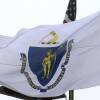Updated July 19 at 7:16 p.m.
The special commission charged with reimagining the Massachusetts state seal is balking at a proposal to feature Ousamequin — the Wampanoag leader whose aid to the Pilgrims of Plymouth Colony is memorialized by the holiday of Thanksgiving — in any redesign.
The idea of using the image of Ousamequin, who was known to the Pilgrims as Massasoit, was broached in the commission’s July 19 meeting by Cheryl Andrews-Maltais, the tribal chairwoman of the Wampanoag Tribe of Gay Head (Aquinnah).
Andrews told her fellow commissioners that, in a letter sent prior to the meeting, her tribal council had proposed replacing the image of an Indigenous man currently on the seal with an image drawn from the statue of Ousamequin that stands on Cole’s Hill in Plymouth.
“[We are] trying to ensure that we don’t lose sight of the fact that the Wampanoag people provided aid and assistance to the English settlers in these lands,” Andrews-Maltais said. “We don’t want to lose that historical imagery, or the fact that our assistance played such a critical and central role to the establishment of this country.”

Andrews-Maltais said her council also suggested removing the sword situated above the Native American’s head in the current seal, as well as the downward-facing arrow he is holding, which the symbol’s designer said is supposed to represent peacefulness.
“By removing those other elements ... it helps to eliminate the historical trauma and emotional distress that not only us as Indigenous people, but all Indigenous people worldwide feel when they see an image of a sword over the head of a Native person,” Andrews-Maltais said.
The Native American currently depicted on the seal is an amalgam created without tribal input, a fact commission co-chair Brian Boyles, the executive director of Mass Humanities, noted before commission voted to change the seal in May.
“The face [of the Native American] was taken from a photograph plucked by the [Massachusetts] secretary of state at that time, William Olin, from the Bureau of Ethnology in Washington, D.C. of Thomas Little Shell, a Chippewa leader who never resided in Massachusetts,” Boyles said in the spring. “The figure is based on a skeleton [that was] held in the Peabody Museum at ... Harvard University. No Native residents were consulted in this selection.”
Commissioner Elizabeth Solomon, the treasurer of the Massachusett Tribe at Ponkapoag, forcefully pushed back at the proposal , which she said would elevate the Wampanoag at the expense of other tribes.
“There were multiple tribal entities within what is now known as the commonwealth at the time of colonization,” Solomon said. “All of them had impacts on what happened later. And I do think that we need to look at this very broadly.
“It’s a very complex interaction between multiple native peoples and the colonists,” Solomon added.
Several other commissioners voiced skepticism of the Ousamequin suggestion, including Donna Curtin, the executive director of Plymouth’s Pilgrim Hall Museum.
Hall urged her colleagues to eschew the human form for symbols that “speak much more broadly and inclusively to both the Indigenous history of the commonwealth — obviously, that is a huge part of our undertaking here — but also, equally powerfully and meaningfully, to the non-Indigenous citizens and residents of our commonwealth, and the broader scope of our history.”
Her concerns were echoed by commissioner Michael Comeau, the executive director of the Massachusetts Archives.
“We’re walking into a minefield here,” Comeau said. “You have to be very careful that whatever symbols you use are not something that is ... representative of a single group.”
While no vote was taken on the Ousamequin proposal, the feedback it elicited suggested the commission does not view it favorably.
Whether any other symbol or set of symbols will fare better is uncertain, however.
At one point in Tuesday’s meeting, Solomon noted that symbols which might, at first, seem to have broad appeal — including the cranberry and the cod — could have different connotations for Indigenous and non-Indigenous populations, given their roles as catalysts for colonization.
“Any particular symbol will have two sides to it,” she said. “I don’t have any objection to the cod, but in the same light as ... the cranberry, the cod also has both good symbolism and potentially bad symbolism. And if we were to [use them], then that would mean in our educational materials, we would have to explicitly talk about that.”
Commissioner Jim Wallace then mentioned another symbol that’s been suggested to him — while acknowledging that it, too, might prove problematic.
“I don’t know if it’s going to be well accepted, but I had several people contact me once they learned I was on the commission and were really adamant that if we’re going to redo a seal ... that the minuteman should be part of that, because to them, that’s the symbol of ultimate freedom,” said Wallace, a pro–gun rights lobbyist.
The exact process by which the commission will select the symbols for a new seal is unclear.
The consideration of various possibilities Tuesday followed a recent meeting of the commission’s Research and Design Subcommittee, at which different options were discussed. Two days earlier, though, the commission’s Public Consultation Subcommittee had weighed the possibility of eliciting or evaluating ideas through public-opinion polling — even though, at present, the commission lacks the funding necessary to commission such a survey.
The commission, which was originally supposed to finish its work last October and is now hoping to wrap up by March 2023, is scheduled to meet again on August 16.
This article has been updated to describe the origins of the Native American represented on the current seal.






